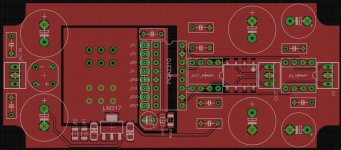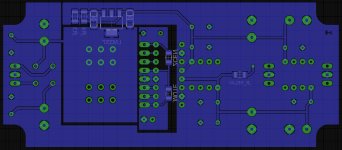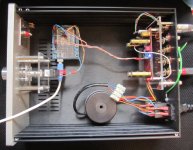Try lowering Vd - the digital supply.
I have no clicks, noise or any other problems on my implementation. However, I took a lot of care in the layout - the uController is isolated competely from the PGA via optos. The rise fall times on the digital control signals are as a result quite slow was well (a few us) and this also helps since you don't have fast rising edhes in the vicinity of the chip.
I have no clicks, noise or any other problems on my implementation. However, I took a lot of care in the layout - the uController is isolated competely from the PGA via optos. The rise fall times on the digital control signals are as a result quite slow was well (a few us) and this also helps since you don't have fast rising edhes in the vicinity of the chip.
I have no clicks, noise or any other problems on my implementation. However, I took a lot of care in the layout - the uController is isolated competely from the PGA via optos.
Is this the schematic of your implementation?
http://hifisonix.com/wordpress/wp-content/uploads/2010/10/Ovation-SC-11.pdf
Would you care to share your layout? Or critique mine?
Attachments
Yes, thats the one.
I'll try to take a look at your layout later tonight.
Just to confirm, when you are changing volume you are hearing clicks? Any other noise/hum you are pickingup?
I'll try to take a look at your layout later tonight.
Just to confirm, when you are changing volume you are hearing clicks? Any other noise/hum you are pickingup?
Just to confirm, when you are changing volume you are hearing clicks? Any other noise/hum you are pickingup?
No clicks for me, just high noise floor (not hum).
How are you coupling your control signals to the PGA - is it a cable, or does the controller plug onto the pins?
"USB DAC ---> PGA ---> Hypex Amp ---> Speakers = Noisey""
I am willing to bet you have radiated noise from your Hypex units, or, mains conducted noise from the SMPS I see in your photo.
If you have a common mode choke, you might try that on the mains cable. Only other alternative is to move the hypex modules further way. If the noise goes down when you do this, it likely radiated noise - if not, look at mains conducted noise.
I am willing to bet you have radiated noise from your Hypex units, or, mains conducted noise from the SMPS I see in your photo.
If you have a common mode choke, you might try that on the mains cable. Only other alternative is to move the hypex modules further way. If the noise goes down when you do this, it likely radiated noise - if not, look at mains conducted noise.
reading comprehension not your best skill, huh?
I can tell a gambler from a designer by the language he uses any day.
I can tell a gambler from a designer by the language he uses any day.
Enough with the trolling, you're not really contributing to this thread!
How are you coupling your control signals to the PGA - is it a cable, or does the controller plug onto the pins?
See the attached picture. The thing on the top left of the case is the Arduino which is connected to the encoder, USB and the PGA module. The PGA modules gets Vd from the Arduino/USB. Before you suspect the USB for the noise, I've tried setting the volume and then disconnecting the power to the Arduino as once the PGA volume has been set it stays even when the digital section is not powered. I've also tried battery power.
ok - if you short the inputs, what happens
Short the input to the Hypex amp or the input to the PGA? When the PGA input is shorted, there is noise. When the Hypex input is shorted, it is silent.
If you have a common mode choke, you might try that on the mains cable. Only other alternative is to move the hypex modules further way. If the noise goes down when you do this, it likely radiated noise - if not, look at mains conducted noise.
Both the Hypex Amp and the PGA module power supplies have mains filters, similar to this thing. I tried plugging the PGA module into the mains on the other side of the room, no change.
I appreciate your input 🙂
Attachments
If is schematic in post 22 valid, I see here more possible problems:
Undefined ground potential at inpput (missing resitors from OA +Inputs to groud), missing input hf filtering (some RC lowpas at inputs, blocking capacitors..), missing series resitors (15-100R) in outputs, capacitive load (cable ..) can cause instabilty and oscilations-manifests itself sometimes as noise.. Output opamps are not needed, PGA internal opamps can drive relatively low loads (600ohm an more) direct.
Undefined ground potential at inpput (missing resitors from OA +Inputs to groud), missing input hf filtering (some RC lowpas at inputs, blocking capacitors..), missing series resitors (15-100R) in outputs, capacitive load (cable ..) can cause instabilty and oscilations-manifests itself sometimes as noise.. Output opamps are not needed, PGA internal opamps can drive relatively low loads (600ohm an more) direct.
If is schematic in post 22 valid, I see here more possible problems:
Undefined ground potential at inpput (missing resitors from OA +Inputs to groud), missing input hf filtering (some RC lowpas at inputs, blocking capacitors..), missing series resitors (15-100R) in outputs, capacitive load (cable ..) can cause instabilty and oscilations-manifests itself sometimes as noise.. Output opamps are not needed, PGA internal opamps can drive relatively low loads (600ohm an more) direct.
So, you mean the following:
1. Some resistors from Input to GND, say 10k?
2. Input capacitors, as in caps in a series with the signal?
3. Resistors in series with the output, say 100R?
I wouldn't assume that the setup with headphones automatically means that the problem is with the hypex amp or wherever one is assuming the noise is coming from.
With my implementation of the CS3318, I had it driving opamps in an inverting configuration that used the smallest resistor that the datasheet said the device could safely drive, this is something like 2.5k. Setup like that the system had something like 105dB SnR and when feeding the power amps + speakers resulted in a noise level that was far too high for comfort. I redesigned the output buffers to work non inverting instead and boom 120dB SnR and the problem was gone.
I mention this because another CS3318 also drove a headphone-driving, power-opamp, in the same general configuration, with the 2.5k resistors. This also had the same degraded SnR ratio, but through the headphones (HD650s) was completely inaudible. The reason why it was a problem through the power amp was because of the 30dB gain and 95dB drivers. The headphone amp on the other hand only had a gain of 2.
It could just be that the PGA/implementation is the culprit and is being noisy.
I don't know if this has been mentioned, but if another power amp, with gain similar to that of the hypex, could be tried instead, it would help to localise where the problem is.
With my implementation of the CS3318, I had it driving opamps in an inverting configuration that used the smallest resistor that the datasheet said the device could safely drive, this is something like 2.5k. Setup like that the system had something like 105dB SnR and when feeding the power amps + speakers resulted in a noise level that was far too high for comfort. I redesigned the output buffers to work non inverting instead and boom 120dB SnR and the problem was gone.
I mention this because another CS3318 also drove a headphone-driving, power-opamp, in the same general configuration, with the 2.5k resistors. This also had the same degraded SnR ratio, but through the headphones (HD650s) was completely inaudible. The reason why it was a problem through the power amp was because of the 30dB gain and 95dB drivers. The headphone amp on the other hand only had a gain of 2.
It could just be that the PGA/implementation is the culprit and is being noisy.
I don't know if this has been mentioned, but if another power amp, with gain similar to that of the hypex, could be tried instead, it would help to localise where the problem is.
With my implementation of the CS3318, I had it driving opamps in an inverting configuration that used the smallest resistor that the datasheet said the device could safely drive, this is something like 2.5k. Setup like that the system had something like 105dB SnR and when feeding the power amps + speakers resulted in a noise level that was far too high for comfort. I redesigned the output buffers to work non inverting instead and boom 120dB SnR and the problem was gone.
Which resistors are you talking about? In a series with the output of the PGA?
I don't know if this has been mentioned, but if another power amp, with gain similar to that of the hypex, could be tried instead, it would help to localise where the problem is.
I would have done that on day one if I had another amp 🙂
Which resistors are you talking about? In a series with the output of the PGA?
Here I am talking about my implementation with the CS3318. The resistors aren't in what you've got. The point, was that while my implementation was silent when used with headphones, it was noisy with the loudspeakers. Ergo, with your setup, just because the PGA implementation is silent with the headphones that doesn't automatically mean that it is going to be quiet enough to be used with your amplifier and speakers.
So, you mean the following:
1. Some resistors from Input to GND, say 10k?
Yes, this defines the input impedance of the unit too. With this set too high or undefined you can get problems.
2. Input capacitors, as in caps in a series with the signal?
Yes, these block any DC but might not be required. BV however was also referring to an RC network, with R in series and C to ground to form a low pass. This will prevent any high frequency grunge from entering the device that could cause problems.
3. Resistors in series with the output, say 100R?
Absolutely, these are necessary to keep things stable, although whether or not you will get instabilities depends on the cables connected to the system, the load at the other end and then the opamp driving the load. The 100R effectively decouples the output from any parasitic reactance that could cause instability.
Enough with the trolling, you're not really contributing to this thread!
You didn't have any contributions to this thread until I replied.
I think all these suggestions are valid MAXW. So add the series output resistors, add the input bias resistors.
But, I think you still have noise problems from your Hypex units and SMPS. You only have noise when they are connected in h signal chain. You may need some screening and mains filtering to solve this.
But, I think you still have noise problems from your Hypex units and SMPS. You only have noise when they are connected in h signal chain. You may need some screening and mains filtering to solve this.
I doubt it's the Hypex amps + SMPS. I've tried various Hypex-based DIY amps, even next to phono stages, and they're extremely benign in terms of emissions. I've had more trouble with Class AB amps and their noisy toroids...
I think all these suggestions are valid MAXW. So add the series output resistors, add the input bias resistors.
OK I'll do that tonight and report back!
- Status
- Not open for further replies.
- Home
- Source & Line
- Analog Line Level
- Getting a PGA2310 to be silent



